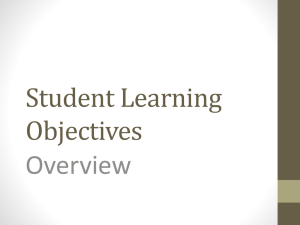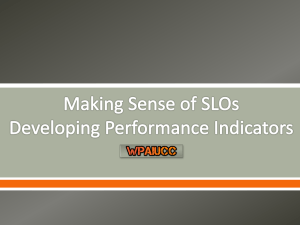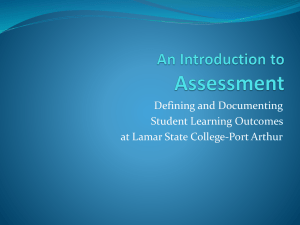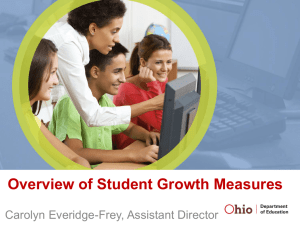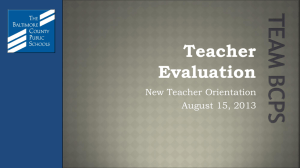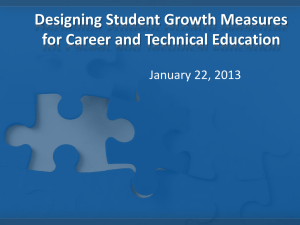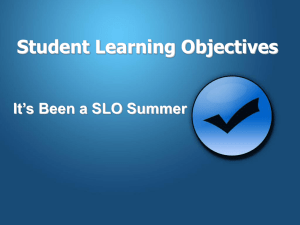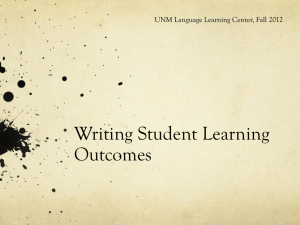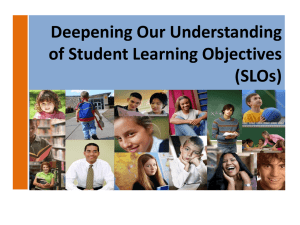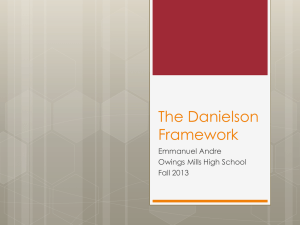Developing SLOs in Arts Education
advertisement
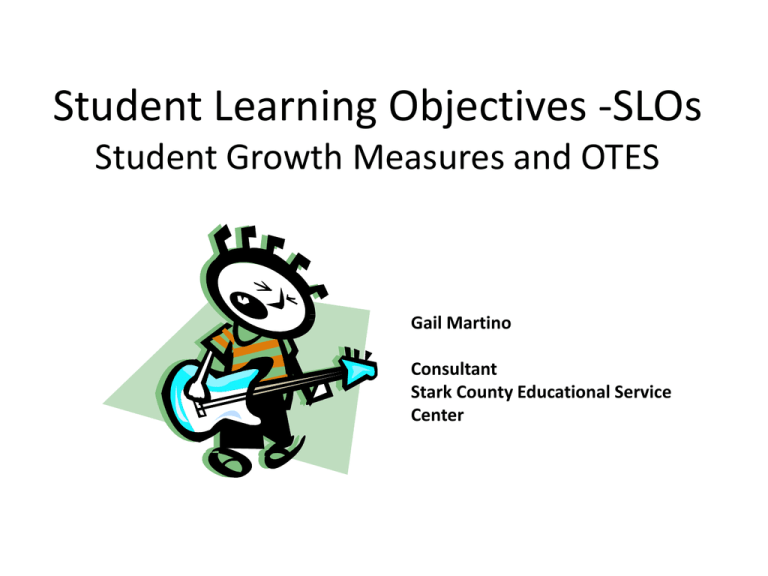
Student Learning Objectives -SLOs Student Growth Measures and OTES Gail Martino Consultant Stark County Educational Service Center The time to do this is NOW! (Implementation Year will be here before we know it!) Stark County Educational Service Center • Serves 21 local, city, and exempted village districts in northeastern Ohio • Pilot included 52 Art and 51 Music teachers • Art Advisory Committee and Music Advisory Committee – met before and after summer SLO writing sessions • Submitted more than 50 Art SLOs and 50 Music SLOs OUR PROCESS • Six full days for Art Teachers; six full days for Music Teachers (July and August) • One hour PPT introduction; an in-depth look at Student Growth Models and Student Learning Objective (SLO) for anyone who had not been in a session yet • Used online template and checklist • Sent completed work in for feedback for first few days Our Process (continued) • Teachers ALWAYS worked in teams – three of more when possible • “Finished” SLOs were reviewed a FINAL time using the checklist • Advisory Committees reviewed all SLOs one final time before they were submitted What is our task? To develop Student Learning Objectives (SLOs) for each grade and course that do NOT have Value Added data or data from an assessment on the ODE Approved Vendor List – and for some of those, too!! What is an “SLO”? A measurable, long-term academic goal informed by available data that a teacher or teacher team sets at the beginning of the year for all students or subgroups of students. An SLO is one of 3 types of STUDENT GROWTH MEASURES. (handout) Why are we doing this? • ODE requirements related to new teacher evaluation - OTES • To improve and track student achievement • To be a part of the process – to have input into what we teach and how we know what students have learned “SLOs are our FRIENDS!” R.R. How are we doing this? • Working together in teams using the ODE’s template and tools • Following the ODE’s directives; using the checklist • Piloting; discussing; revising What else do we know about SLOs? • Must reflect BIG ideas; most important grade level or course learning (Power Standards?) • Must reflect 21st century learning • Must be standards-based • Must use ODE’s template and checklist • SLOs will be different for most teachers – will be tailored to fit the students and the situation What are the specifics about the assessments? • May include multiple measures Written, performance, portfolio • Authentic assessment – objective attainment of learning included in the SLO • Pre/post (Growth model) What is included in an SLO? The template is found on the ODE website: http://www.ode.state.oh.us Click on “Educator Evaluation” And then “Student Growth Measures” The TEMPLATE and the SLO Checklist MUST BE USED TOGETHER SLO COMPONENTS • • • • • • • Baseline and Trend Data Student Population Interval of Instruction Standards and Content Assessment(s) Growth Target(s) Rationale for Growth Targets ASSESSMENTS • Best if teachers do not create their own assessment, but this might have to occur in some cases. • Assessments can be state tests that do NOT have Value Added data. • Assessments should measure higher level thinking skills. • Assessments should be representative of total content. • ODE has a NEW checklist for selecting assessments. Are there rules or non-negotiables? • The Ohio Department of Education suggests 2 to 4 SLOs per teacher. SLOs must be representative of teacher’s overall teaching assignment. • SLOs must be based on ODE’s Student Growth Model – demonstrating objective measurement of student achievement of the SLO. • SLOs must be broad enough to encompass the most essential learning for each grade and course, including the content standards related to that learning. • SLOs must also be specific enough to measure student growth and provide data to demonstrate that growth. • Districts may study the SLOs recommended by the SCESC pilot and other pilots and then make adjustments as needed to meet district’s needs. • Each district must approve SLOs for each grade or course not covered completely by Value-Added measures or the ODE Approved Vendor List. SLOs must be finalized by November, 2013. Timeline 2012-2013 Writing Year and PILOT YEAR (Implementation Year for RttT Districts that fully implement OTES!) 2013-2014 Implementation Year for ALL OTHER DISTRICTS (as part of the OTES) – unless contract dates overlap. What’s NEW? • Teachers will use a “Scoring Calculator” to report data from SLOs. • Teachers enter SLO data into a spreadsheet. • This Scoring Calculator is found in Appendix A of the SLO Guidance Document on the ODE SLO site. • SLO data must be reported by mid-April of reporting years for eTPES reporting by May 1. IMPORTANT TOOLS on ODE Site • Steps for Designing a Local Student Growth Plan • SLO Template • SLO Checklist • (MUST READ and RE-READ) Guide to Using Student Learning Objectives • Educator Evaluator Updates on ODE website (Check regularly!) Additional Resources • Sample SLOs for MUSIC and ART in SCESC website • Sample SLOs from other pilot districts • SLO shared by districts in the Stark County region (may be posted on the SCESC website) Teachers Need……. • Time to develop SLOs. Every teacher should create at least one. • Time to work together across the district to create and/or edit sample SLOs • Time to pilot the SLOs – particularly if new assessments have been created or obtained. • Regularly scheduled time to discuss the SLOs and the students’ progress throughout the year. FIRST STEPS for District Administrators • Read/study the documents on the ODE web site. • Formulate a district plan – for each teacher – which SGMs and how many. • Create a system for building/district approval of SLOs. • Refer to ODE’s Educator Evaluation website regularly for updates and Teacher Tools. First Steps (continued) • Strive to enable every teacher to have someone in their area with whom to collaborate to develop/finalize SLOs. • Strive for consistency across the district whenever possible. • Remind teachers that SLOs are NOT TESTS for which students cram or study. Pre-assessments should not be GRADED. • Remind teachers that we have SLOs so that teachers will use the best possible instruction and so that students will all learn and demonstrate growth. eTPES – Ohio Teacher and Principal Evaluation System • Electronic reporting system • Value Added data will be populated by ODE. • All other SGM data will be entered by LEA. LESSONS LEARNED FROM THE PILOT • Many teachers do not have baseline data or trend data. • Creating assessments is challenging; ODE support in SLO Guide is helpful! • Teachers really NEED to work together to create SLOs. • Teachers MUST use the SLO checklist. More lessons learned…. • Setting targets is a different concept for most teachers. Difficult to do when you have not given the assessment yet. • Some teachers have hundreds of students and need to consider how to assess and document that assessment. More lessons learned… • Teachers need to think about creating or implementing assessments that do NOT take up a great deal of instructional time – especially those who only see students once each week. • Districts need to address how to handle students who come in after school starts – or mid-year Final Words of Advice 1. Stay calm. 2. Educate EVERYONE. Involve EVERYONE. Encourage EVERYONE. Support EVERYONE. 3. Say the word “Rigor” as often as possible. 4. Be flexible. Be patient. 5. Check the ODE website regularly for updates 6. PRAY HARD. 7. Lead with courage and be positive. 8. Smile and laugh as often as possible. 9. Don’t be afraid to ask for help. No one can do all of this alone. Thanks for your kind attention!
